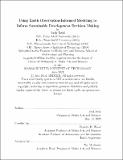Using Earth Observation-Informed Modeling to Inform Sustainable Development Decision-Making
Author(s)
Reid, Jack
DownloadThesis PDF (53.54Mb)
Advisor
Wood, Danielle R.
Terms of use
Metadata
Show full item recordAbstract
This work aims to demonstrate the viability of a methodology for supporting local, sustainable development decision-making through the development of clearer linkages between environmental modeling and societal impact, with a particular emphasis on the use of earth observation data. To accomplish this, it explores the efficacy and difficulties of collaboratively developing a systems-architecture-informed, multidisciplinary GIS decision support system for sustainable development applications that makes significant use of earth observation data.
This is done through the development and evaluation of decision support systems (DSSs) for two applications: (1) mangrove forest management and conservation in the state of Rio de Janeiro, Brazil; and (2) coronavirus response in six regions around the world. In both cases, the methodology involves the application of the System Architecture Framework, which includes analyzing the stakeholders to inform the design of the DSS in question. Other components of the methodology are developing the DSS through a collaborative process with stakeholders; pursuing targeted analyses; and evaluating the usefulness of both the DSS and the development process through interviews, workshops, and other feedback mechanisms.
All of this takes place under the umbrella of the Environment, Vulnerability, Decision-Making, Technology (EVDT) Framework for combining remote observation and other types of data to inform decision-making in complex socio-environmental systems, particularly those pertaining to sustainable development. As the name suggests, EVDT integrates four models into one tool: the Environment; Human Vulnerability and Societal Impact; Human Behavior and Decision-Making; and Technology Design for earth observation systems including satellites, airborne platforms and in-situ sensors. The data from each of these domains is used by established models in each domain, which are adapted to work in concert to address the needs identified during the stakeholder analysis. The capabilities provided by this framework will improve the management of earth observation and socioeconomic data in a format usable by non-experts, while harnessing cloud computing, machine learning, economic analysis, complex systems modeling, and model-based systems engineering.
Date issued
2023-06Department
Program in Media Arts and Sciences (Massachusetts Institute of Technology)Publisher
Massachusetts Institute of Technology